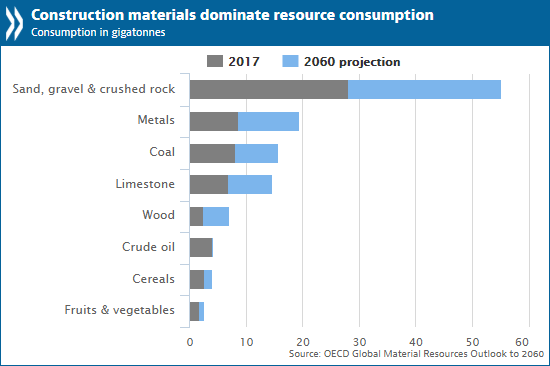Even though sand can be found in nearly every single country on Earth, the world could soon face a shortage of this crucial, under-appreciated commodity. Sand use around the world has tripled in the last twenty years, according to the UNEP. That's far greater than the rate at which sand is being replenished. Here's what's behind the looming sand crisis.I've been showing versions of the following image, originally from the USGS, now from my alma mater the University of Michigan, for more than a decade. It now only displays how much of the various types of non-fuel natural resources Americans have used annually since 1900, but also tracks the ups and downs in consumption and relates them to economic events. It shows both that construction materials, particularly sand, gravel, and stone, constitute the number one category of uses for earth materials and that construction activity goes up and down with the economy.

The following graphic from the OECD shows that sand, gravel, and stone are the number one resource consumed worldwide, excluding water as CNBC noted.

Add metal, limestone (much of which is used to make cement and refine iron ore in addition to being used as stone itself), and wood and the amount of natural resources used for construction literally outweighs just about everything else combined, again probably excluding water.
I agree with CNBC that sand mining serves as an example of the Tragedy of the Commons, a concept that is central to environmental science, but one that I've never mentioned in this blog before. One the one hand, that's because I emphasize Commoner's Laws over the Tragedy of the Commons. On the other, it's long past time for me to write about it; eleven years of ignoring it on this blog is too long.
Speaking of Commoner's Laws, all four of them apply, particularly "everything is connected to everything else" and "there is no free lunch," but also "there is no waste in nature" part of "there is no away" and the chemical cycling part of "nature knows best." I'm glad to hear these mainstream economists talk about the circular economy, a concept environmental and ecological economists have been advocating on behalf of for decades.
Before I move on, both CNBC and the OECD point out that use of construction materials will continue to increase because of growing population, more urbanization, and, hopefully, rising affluence. That will require more regulation of mining, building more durable structures to reduce use, and increasing recycling of building materials.
I close today's entry with SciShow's telling of this tale, The World Is Built on Sand... and We're Running Out, which has more science and technology and less economics and government.
Some might call sand coarse, rough and irritating, but there’s no denying that it’s used everywhere: from glass to asphalt, sand is a key ingredient for all sorts of materials in construction and technology. But this heavy reliance on sand means that we’re also reaching a limit on this seemingly infinite resource.Yes, the basic facts about sand use are the same, but the difference in details and emphasis matters. I would show the CNBC video to my environmental science students and the SciShow video to my geology students. I just might add both videos to my lectures.
That's it for a week of resource stories I tell my students. Stay tuned for the Sunday entertainment feature followed by an observance of Memorial Day.
plastic. Hemp. Repurpose.
ReplyDeleteThose will help, maybe enough to make up any shortfall, but I don't think they will completely replace natural beach and river sand.
DeleteBamboo. Plastic. Hemp. Repurchased materia. construction.
ReplyDeleteBamboo? Maybe. Recycled construction materials look like a better bet.
Delete